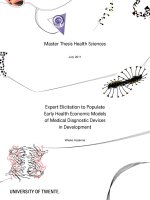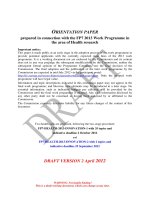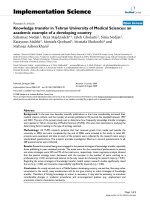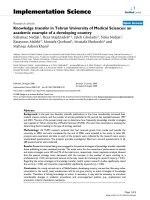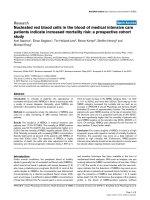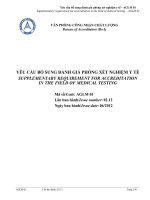Dynamism in resistance pattern of escherichia coli-a drift from Indian council of medical research (ICMR)-antimicrobial use guidelines
Bạn đang xem bản rút gọn của tài liệu. Xem và tải ngay bản đầy đủ của tài liệu tại đây (192.22 KB, 6 trang )
Int.J.Curr.Microbiol.App.Sci (2020) 9(8): 2911-2916
International Journal of Current Microbiology and Applied Sciences
ISSN: 2319-7706 Volume 9 Number 8 (2020)
Journal homepage:
Original Research Article
/>
Dynamism in Resistance Pattern of Escherichia coli-A Drift from Indian
Council of Medical Research (ICMR)-Antimicrobial Use Guidelines
V. D. Sathish1*, Guru Prasad Mohanta2,
Elizabeth Anna Mathew2 and J. Renga Ramanujam3
1
Department of Pharmacy Practice, KMCH College of Pharmacy,
Coimbatore, TamilNadu, India
2
Department of Pharmacy, Annamalai University, Chidambaram, TamilNadu, India
3
Department of Microbiology, DR.N.G.P Arts and Science College, Coimbatore,
Tamil Nadu, India
*Corresponding author
ABSTRACT
Keywords
Antibiotics,
Treatment,
Surveillance,
Escherichia coli,
Resistance,
Meropenem,
Sensitivity
Article Info
Accepted:
22 July 2020
Available Online:
10 August 2020
Combating Antibiotic resistance has become a great challenge for clinicians due to
inappropriate use of antibiotics. Antibiotics once considered being magic bullet is no more
having that title. Recommendation in AMR situation in India by Department of
Biotechnology (DBT) and Treatment Guidelines for Antimicrobial Use by Indian Council
of Medical Research (ICMR) India emphasized the need for regional surveillance starting
from the level of state to an individual hospital has been motivation behind the study.
Three hospitals in region of Cuddalore in Tamilnadu (India) have been the source of
specimen for isolation of Escherichia coli during the period of January to July 2019.
Antibiogram reports were collected during the study period and utilized for the study.
Among 124 isolates Urine, High vaginal swab, Pus, Serum, Oral swab and Amniotic fluid
occupied 81.45% (n-101), 08.06%(n-10), 5.64%(n-7), 2.41%(n-3), 1.62%(n-2) and 0.81%
(n-1) respectively. Antibiogram for the Escherichia coli isolates revealed 90% of
resistance to Cefepime, 68% to Ciprofloxacin, 50% to Tetracyclin, 30% to Meropenem
etc., Similarly high percentage of sensitiveness was evident in Cefotaxime (95.94%),
Imipenum (95.91%), Piperacillin/Tazobactem (86%), Meropenem (70%) etc. On
comparison with the 2014 ICMR (Antimicrobial Susceptibility) data percentage of
resistance and susceptibility has a drastic change both in resistance and sensitivity. From
the study it is clear that the generic recommendations on antibiotic use at national level
can’t be a desirable solution or recommendations to clinicians. The study signifies the
importance of local surveillance and infection control programs.
Introduction
E.coli is a gram negative, facultative
anaerobic, rod shaped and coliform bacteria
responsible for wound infection, food
poisoning, lower urinary tract infection, upper
urinary tract infection, septicemia, peritonitis,
mastitis and pneumonia. In hospital
community acquired infections UTI plays
significant role due to use of catheters and
administration of immunosuppressive drugs
in extended hospitalization in extreme clinical
2911
Int.J.Curr.Microbiol.App.Sci (2020) 9(8): 2911-2916
conditions (Lim et al, 2017) (1). All the
studies related to E. coli have consistently
confirmed its dominance in urine samples
than other specimens.
resistance pattern of E. coli from different
clinical specimens and comparing with ICMR
guidelines as a point of reference.
Materials and Methods
Urinary tract infection (UTI) affects part of
the urinary tract. If it affects the lower urinary
tract it is named as a bladder infection
(cystitis) and upper urinary tract it is known
as kidney infection(pyelonephritis) (Flores et
al, 2015) (2). The most predominant causative
agent of infection is Escherichia coli,
although the other bacteria may rarely be
responsible.
Female
anatomy,
sexual
intercourse, diabetes, obesity, and family
history are the responsible risk factors. UTIs
are treated with a short course of antibiotics
such as nitrofurantoin or trimethoprim/
sulfamethoxazole (Salvatore et al, 2011) (3).
In the last two decades, it is challenging to
treat UTI infections caused by bacterial
pathogens particularly that are transmitted in
hospitals, because they are becoming resistant
faster than we could develop new antibiotics.
At present we have to depend on using toxic
medications with potential and serious side
effects due to the limitation that they are the
only options available to treat infections from
the multi-drug resistant bacteria (Wainwright
and Milton 1989) (4).Lack of effective
antibiotics is as serious as threat to security
that will end in more mortality and sudden
disease outbreak. Quick emergence of
resistant bacteria/infections has again become
a threat.
There are evidences in a study by Kalapana et
al, (2001) (5) in United States of America that
the resistance by Escherichia coli to
trimethoprim-sulfamethoxazole differed from
region to region with a difference of 12%
from 22% in western region to 10% in
northeast region. In this study we have limited
our surveillance within the region of
Cuddalore-Tamilnadu (India) for knowing the
Two hundred clinical samples like Urine,
High vaginal swab, Pus, Serum, Oral swab
and Amniotic fluid were collected in three
private hospitals in Cuddalore and were
streaked in selective media EMB agar (HiMedia) for isolation and identification of
E.coli. Green Metallic sheen colonies were
further confirmed for Gram staining, Motility
and Standard Biochemical tests like, IMViC,
CHO fermentation test, TSI test, Citrate
utilization test, Catalase, Oxidase and
Coagulase test. After the confirmation the
confirmed isolates were inoculated into
nutrient broth (Hi-Media) for multiplication.
0.5 MacFarl and standard was ensured for
antibiotic sensitivity testing of all the 124
isolates to have 1.5X108 cells/ml (Baker et al,
1983) (6).
After multiplying process standardized
inoculums of each isolate were inoculated on
to Mueller-Hinton antibiotic sensitivity
medium (Hi-Media). Finally, all the isolates
were tested for these under listed drug discs:
Amikacin,
Cefepime,
Cefotaxime,
Ceftazidime, Ciprofloxacin, Gentamycin,
Imipenem,
Meropenem,
Piperacillin/
Tazobactem and Tetracycline. Standard
antibiotic discs (Hi Media) were placed into
the bacteria inoculated medium. Sterile
conditions were taken care during this
process. Incubation; waiting period was for 24
hours.
Depending upon the size of the zone, on
comparison with the standard chart, and
reviewing with guidelines of Clinical
Laboratories Standard Institute (CLSI) for
Antimicrobial Susceptibility Testing; the
isolates were determined whether they are
2912
Int.J.Curr.Microbiol.App.Sci (2020) 9(8): 2911-2916
susceptible, moderately sensitive or resistant.
The susceptibility breakpoints for each
antibiotic were defined according to Clinical
Laboratory Standards Institute (CLSI)
guidelines
(CLSI,
2011)
(7).
The
susceptibility patterns were recorded under
three categories like sensitive, intermediately
sensitive/resistant and resistance. Final reports
were collected and utilized for the study.
Results and Discussion
From the 200 clinical specimens collected
124 E. coli isolates were obtained with more
no of isolates from urine sample having high
frequency of 81.45 % (n-101). It was
followed by high vaginal swab, pus, serum,
oral swab and amniotic fluid which are
explained in Table 1.
According to Kibret and Abra (2011)(8)
highest isolation percentage for E. coli was
obtained in urine samples 203 (45.5%). In a
study by Devanand and Saxena, 2013 (9),
among the gram negative isolates from urine
sample 61.45% were E.coli, out of which
54.90% were isolated from inpatients of
hospitals and 45.10% were from the
community.
Our study results are in accordance with
previous studies with the prevalence of
81.45% clearly indicating the dominance of
E. coli in urinary tract infections. Ideal results
have been reported by Poonam (2012) (10)
also. Similarly many studies have reported the
prevalence of UTI infections in Women than
men indicating the high risk situation for the
female inpatients.
In a study by Kibret and Abra in 2011(11)
high resistance erythromycin (89.4%),
amoxicillin (86.0%) and tetracycline (72.6%)
were recorded. Multi drug resistance of
74.6% and increased resistance rates to all
antibiotics except ciprofloxacin were also
recorded. E. coli isolates showed high rate of
resistance to erythromycin, amoxicillin and
tetracycline. Wani et al, (2009) (12)
conducted a susceptibility study in E. coli
clinical isolates and reported higher
percentage of resistance to ceftazidime
(99.2%), cefotaxime (99.2%) and ceftriaxone
(99.5%). Similarly, Rafay et al, (2007) (13)
the study in tertiary care hospital in KashmirINDIA during 1st August 2005 to 31st July
2007, demonstrated 100% resistance of E.
coli to cephalosporins. Duttaroy and Mehta
(2005) (14) the study was done in Medical
College Baroda-Gujarath in 2005, reported
resistance of E. coli up to 75% to cefotaxime,
85% to ceftazidime and 60% to ceftriaxone.
Kibret and Abera (2016) (15) the study was
aimed at determining ESBL and antibiogram
in Enterobacteriaceae isolates from clinical
and drinking water sources in Bahir Dar City,
Northwest Ethiopia during September 2013 to
March 2015.
The antibiogram study of erythromycin,
amoxicillin and tetracycline on E. coli
isolated from UTI patients, and found high
rates of resistance to erythromycin (89.4%),
amoxicillin (86.0%) and tetracycline (72.6%),
respectively.
Complete susceptibility pattern of all E.coli
isolates from Cuddalore region is found in the
Table 2. Resistance to third generation
cephalosporins cefepime, cefotaxime and
ceftazidine is 90%, 04.05% and 04.00%
respectively by our isolates. Resistance to
cefotaxime and ceftazidime has been
significantly reduced with a reduced difference
of 75% by the isolates of Cuddalore region but
with increased level of resistance against
cefepime with 11% only. The samples chosen
for framing ICMR Treatment Guidelines for
Antimicrobial Use by ICMR India in 2017 have
been hospitals of national significance with
more inpatients of extended hospitalization
(Jena et al, 2013) (16).
2913
Int.J.Curr.Microbiol.App.Sci (2020) 9(8): 2911-2916
Table.1 Showing prevalence of E. coli in clinical specimens
S. No.
01
02
03
04
05
06
Name of the Specimen
Urine
High Vaginal Swab
Puss
Serum
Oral Swab
Amniotic Fluid
No of Isolates (E. coli)
101
10
07
03
02
01
Percentage of Prevalence (%)
81.45
08.06
05.64
02.41
01.62
00.81
Table.2 Showing the susceptibility pattern of the E. coli isolates in reference to susceptibility
pattern described in ICMR Treatment Guidelines for Antimicrobial
Use by ICMR India in 2017(17)
S.No
01
02
03
04
05
06
07
08
09
10
Antibiotic
E. coli isolates of our study (n-124)
Sensitive
Intermed
Resistant
N
%
n
%
n
%
Third and fourth generation Cephalosporins
Cefepime
12
10.00
0
0
112 90.00
Cefotaxime
119 95.40
0
0
5 04.05
Ceftazidime
18
14.66
101 81.33
5 04.00
Fluoroquinolones
Ciprofloxacine
34
27.27
6
04.50 84 68.18
Aminoglycosides
Amikacin
78
63.01
46
37.00
o
0
Gentamicin
72
58
5
04.00 47 38.00
Carbapenems
Imipenem
119 95.91
0
0
5 04.09
Meropenem
87
70.10
0
0
37 30.00
Tetracyclines
Tetracycline
62
50.00
0
0
62 50.00
Pecillin
Piperacillin/Tazobact
107 86.00
5
04.00 12 10.00
um
The possibility for extensive consumption of
life saving antibiotics would have surely led
to increased exposure of pathogen (E.coli) to
the antibiotics leading to prevalence of multidrug resistant bacteria in those areas.
Empirical treatment based on guidelines as
prophylactic measures might be also one of
the reason for increased exposure. Another
remarkable change that isolates have been
ICMR India
National % of
Resistance
79.00
80.00
81.00
81.00
24.00
46.00
18.00
35.00
64.00
43.00
more resistant to fourth generation
cephalosporins than third generation on head
to head study indicating the acquired
resistance from extensive usage of fourth
generation cephalosporins.
In a study by Tanzina et al., 2016 (18) in
Bangladesh where antibiotic sensitivity test
on E. coli isolates demonstrated that they
2914
Int.J.Curr.Microbiol.App.Sci (2020) 9(8): 2911-2916
were highly sensitive to Amikacin,
Gentamycin,
Netilmycin,
Imipenem,
Meropenem,
Pipracillin-Tazobactam,
Tobramycin, Nitrofurantoin, Azithromycin,
Levofloxacin, and Ciprofloxacin.
Declaration of interest
In our study apart from third generation
cephalosporin other group of antibiotics like
fluoroquinolones,
aminoglycosides,
carbapenems, tetracyclines, penicillin have
steadily shown drift in reduction of resistance
percentage raging from minimum of 05%
under carbapenems to maximum of 33% in
penicillin group (Piperacillin/Tazobactem), a
positive sign to revert back to conventional
antibiotics until the sensitivity reaches 100%
for the above classes (Mandal et al., 2001)
(19). May be the drift in the form of adaptive
resistance by E.coli to newer generation,
costly, life saving and high side effect
antibiotics will lead to change in efflux
mechanisms and receptor modulations.
Acknowledgement
In conclusion to develop a nationwide policy
in 2017 the susceptibility pattern data of 2014
has been utilized clearly spacing 2015 and
2016. “AMR situation in India by DBT”
Govt. of India (20) has searched the PubMed
and Google Scholar databases relating to
AMR in India, using following terms:
“antimicrobial OR antibiotic and resistance
and India.” The search was limited to the last
five years (July 1, 2012, to June 30, 2017)
(Sumanth et al, 2017) (21). Comparatively it
would give a comprehensive picture on
nationwide susceptibility pattern but limited
to the zones/regions exposed to research
centers or institutes only.
The study clearly emphasizes local
antimicrobial surveillance from hospital level
to combat the major threat (antimicrobial
resistance) to mankind. Only by knowing the
extent of resistance and sensitivity can
appropriate choices of antibiotic can be made.
The authors report no conflict of interest. The
authors alone are responsible for the content
and writing of this article.
No funding was obtained for this study.
Ethical approval is not required for this study.
References
1. Lim, J., Yoon, J.W. and Hovde, C.J.
(2017). A Brief Overview of
Escherichia coli O157:H7 and Its
Plasmid O157. J.Microbiol Biotechnol.
20 (1): pp05–14.
2. Flores-Mireles, A.L., Walker, J.N.,
Caparon, M. and Hultgren, S.J. (2015).
Urinary tract infections: epidemiology,
mechanisms of infection and treatment
options. Nature Reviews. Microbiology.
13 (5): pp269–84.
3. Salvatore, S., Cattoni, E., Siesto, G., Serati,
M., Sorice, P. and Torella, M. (2011).
Urinary tract infections in women.
European
journal
of
obstetrics,
gynecology, and reproductive biology.
156 (2): pp131–136.
4. Wainwright and Milton (1989). Moulds in
ancient and more recent medicine
Mycologist. Vol.3 (1), pp.21–23.
5. Kalpana, G., Daniel, F. S., David, M. and
Walter, E. S. (2001). Antimicrobial
Resistance among Uropathogens that
Cause Community-Acquired Urinary
Tract Infections in Women: A
Nationwide Analysis. Clinical Infectious
Diseases. 33(1): pp89–94.
6. Baker, C.N., Thornsberry, C. and
Hawkinson, R.W. (1983). Inoculum
standardization
in
antimicrobial
susceptibility tests: evaluation of the
overnight agar cultures and the rapid
2915
Int.J.Curr.Microbiol.App.Sci (2020) 9(8): 2911-2916
inoculum standardization system. J Clin
Micro, 17: pp450-457.
7. Clinical and Laboratory Standards Institute
(CLSI).
2012.
Available:
clsi.org/standards.
Accessed:
25
December 2011.
8. 11, 15. Kibret, M. and Abera, B. (2011).
Antimicrobial susceptibility patterns of
E. coli from clinical sources in northeast
Ethiopia. Afri Health Sciences, 11(1): pp
40-45.
9. Devanand, P. and Saxena, R.S. (2013).
Prevalence
and
antimicrobial
susceptibility pattern of Escherichia coli
in hospital acquired and community
acquired patients related to urinary tract
infection in India.Journal of Applied
Pharmaceutical Science, 3 (08): pp.
124-132.
10. Poonam, V. (2012) A study on isolation of
E.coli bacteria from different clinical
specimens in Raipur. Indian Streams
Research Journal. 2(9): pp. 01-04.
12. Wani, K.A., Thakur, M.A., Siraj, F.A.,
Fomdia, B. and Gulnaz, B. (2009),
extended
spectrum
B-lactamase
mediated resistance in Escherichia coli
in a tertiary care hospital. Int J Health
Sci (Qassim) 3: pp. 155-163.
13. Rafay, A.M., Al-Muharrmi, Z., Toki, R.
(2007). Prevalence of extendedspectrum
beta-lactamases-producing
isolates over a 1-year period at a
University Hospital in Oman. Saudi
Med J 28: pp. 22-27.
14. Duttaroy, B. and Mehta. S. (2005)
Extended spectrum b lactamases
(ESBL) in clinical isolates of Klebsiella
pneumoniae and Escherichia coli.
Indian J Pathol Microbiol 48: pp. 45-48.
16. Jena. J., Debata, N.K. and Subudhi, E.
(2013)
Prevalence
of
extendedspectrum-beta-lactamase and metallobeta-lactamase producing multi drug
resistance gram- negative bacteria from
urinary isolates. Indian J Med Microbiol
31: pp.420-421.
17. Indian Council of Medical Research
ICMR Antimicrobial Use Guidelines
2017
18. Tanzina, A., Mohammad, J.H., Md
Sumon, K., Hoomyra, S., Kaniz, F.,
Sohana, A.S. and Suvamoy, D. (2016).
Isolation,
identification
and
antimicrobial susceptibility pattern
analysis of Escherichia coli isolated
from clinical samples of Bangladesh.
Asian Journal of Biomedical and
Pharmaceutical Sciences, 6(54): pp.1316.
19. Mandal, P., Kapil, A., Goswami, K., Das,
B. and Dwivedi, S.N. (2001)
UropathogenicEscherichia coli causing
urinary tract infections. Indian J Med
Res. 114: pp. 207-11.
20.Scoping
Report
on
Antimicrobial
Resistance in India by Department of
biotechnology November 2017.
21. Sumanth, G., Jyoti, J., Anna, T., Anjana,
S.L. and Ramanan, L. (2017). Scoping
Report on Antimicrobial Resistance in
India. Washington, DC: Center for
Disease Dynamics, Economics &
Policy.
How to cite this article:
Sathish, V. D., Guru Prasad Mohanta, Elizabeth Anna Mathew and Renga Ramanujam, J. 2020.
Dynamism in Resistance Pattern of Escherichia coli -A Drift from Indian Council of Medical
Research (ICMR)-Antimicrobial Use Guidelines. Int.J.Curr.Microbiol.App.Sci. 9(08): 29112916. doi: />
2916

